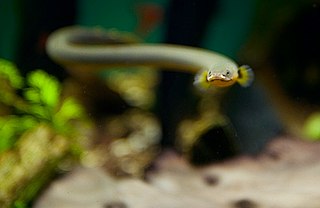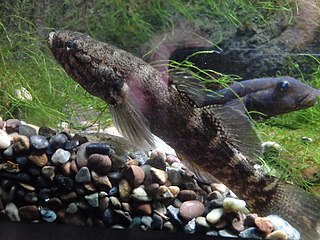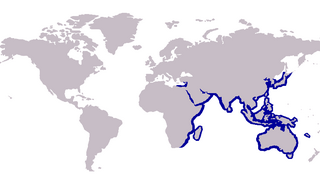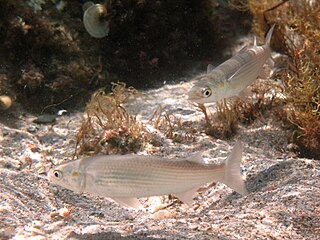
The black sea bass is a species of marine ray-finned fish, a sea bass from the subfamily Serraninae which is part of the family Serranidae, which also includes the groupers and anthias. It is found in the western Atlantic Ocean, where it is an important species for commercial and recreational fisheries.

Angling is a fishing technique that uses a fish hook attached to a fishing line to tether individual fish in the mouth. The fishing line is usually manipulated via a fishing rod, although rodless techniques such as handlining also exist. Modern angling rods are usually fitted with a fishing reel that functions as a cranking device for storing, retrieving and releasing out the line, although Tenkara fishing and traditional cane pole fishing are two rod-angling methods that do not use any reel. The fish hook itself can be additionally weighted with a denser tackle called a sinker, and is typically dressed with an appetizing bait to attract and entice the fish into swallowing the hook, but sometimes an inedible fake/imitation bait with multiple attached hooks is used instead of a single hook with edible bait. Some type of bite indicator, such as a float, a bell or a quiver tip, is often used to relay underwater status of the hook to the surface and alert the angler of a fish's presence.
Hemiramphidae is a family of fishes that are commonly called halfbeaks, spipe fish or spipefish. They are a geographically widespread and numerically abundant family of epipelagic fish inhabiting warm waters around the world. The halfbeaks are named for their distinctive jaws, in which the lower jaws are significantly longer than the upper jaws. The similar viviparous halfbeaks have often been included in this family.

The reedfish, ropefish, or snakefish, Erpetoichthys calabaricus, is a species of fish in the bichir family and order. It is the only member of the genus Erpetoichthys. It is native to fresh and brackish waters in West and Central Africa. The reedfish possesses a pair of lungs in addition to gills, allowing it to survive in very oxygen-poor water. It is threatened by habitat loss through palm oil plantations, other agriculture, deforestation, and urban development.

Triglidae, commonly known as gurnards or sea robins, are a family of bottom-feeding scorpaeniform ray-finned fish. The gurnards are distributed in temperate and tropical seas worldwide.

The gafftopsail catfish is a species of marine catfish found in the waters of the western central Atlantic Ocean, as well as the Gulf of Mexico and the Caribbean Sea. It has long, venomous spines which can cause painful wounds. It feeds on crustaceans and other fish. The male of the species fertilizes the eggs of the female, and broods them in his mouth until they hatch. The gafftopsail feeds throughout the water column. This fish is a common catch in the Southeastern US, although it may be found as far north as New York. They are considered strong fighters by anglers. They are taken from piers, jetties, reefs, and the surf, as well as bottom fishing or flats fishing. They are caught with hard lures as well as soft plastics, cut bait, and live or dead shrimp. Some fishermen use traps for catfish, a method regulated by some states.

Feeder fish is the common name for certain types of small, inexpensive fish commonly fed as live food to other captive animals such as predatory fishes or carnivorous aquarium fish, turtles, crocodilians and other piscivores that naturally hunt in fresh, brackish or salt water ecosystems.

Eleotris sandwicensis, the Sandwich Island sleeper, Hawaiian sleeper or oopu, is a species of fish in the family Eleotridae endemic to the Hawaiian Islands, where it can be found in marine, fresh, and brackish waters around the coast. Due to this capability of migrating between different marine environments, they are amphidromous. This fish can reach a length of 33 cm (13 in). It is locally important to commercial fisheries and is also used as bait by fishermen after larger fishes. In the Hawaiian language, the fish is also known as oʻopu, ʻoau, ʻowau, and hiʻu kole.

The Black bream, also commonly known as the southern black bream, southern bream and blue-nosed bream, is a species of anadromous ray-finned fish of the porgy family Sparidae. A deep-bodied fish, it is occasionally confused with other similar species that occur within its range, but is generally distinguished from these species by a lack of yellow ventral and anal fins. Southern black bream are endemic to the southern coasts of Australia from Shark Bay in Western Australia to Ulladulla, New South Wales, as well as Tasmania.

The razorbelly scad is a small species of tropical marine fish in the jack family, Carangidae. The species inhabits coastal waters in the Indo-Pacific, from Pakistan in the west to Japan and Australia in the east, often found over reefs. The razorbelly scad has a complex taxonomic history, and even recently has had its position in the genus Alepes challenged, but appears to be stable after a molecular phylogeny study supported its placement in Alepes. It is very similar to other scads in the same genus, but is readily identified by its unique teeth. Razorbelly scad are predatory fish, taking a variety of crustaceans and shrimps, and show a change in feeding intensity over the year. Reproduction and development have been extensively studied in India, where spawning occurs in a single event from January to September. The species is commonly taken in tropical fisheries, where it is marketed fresh or dried.

The western school whiting, also known as the banded whiting, golden whiting and bastard whiting, is a species of benthic marine fish in the smelt-whiting family Sillaginidae. The species is one of three 'school whiting' that inhabit southern Australia and share a very similar appearance. Western school whiting are known to grow to 30 cm in length and 275 g in weight, although unconfirmed reports suggest this might be an underestimate. The western school whiting is distributed along the Western Australian coast from Maud Landing in the north to Rottnest Island in the south. The species inhabits both shallow inshore environments and waters to depths of 55 m. The species is a benthic predator, taking a variety of crustaceans, molluscs and echinoderms, and shows a change in diet with age and habitat. S. vittata is a multiple spawner, reproducing between December and February once it has reached one or two years of age. Juveniles inhabit protected inshore waters, moving offshore once they reach sexual maturity. It is often found in association with other sillaginids and comprises a minor fraction of commercial whiting catches in Western Australia.

The vadigo, Campogramma glaycos, is a species of medium-sized coastal marine fish in the jack family, Carangidae. The species is distributed throughout the eastern Atlantic Ocean from the British Isles in the north to Senegal in the south, also entering the western Mediterranean Sea. The vadigo is similar in form to both the leatherjacks and the queenfish, but can be distinguished by its scaleless chest and a broad, rounded upper jaw. It is a predatory fish, preying mostly on smaller schooling fishes. The species was initially classified under the genus Centronotus before being transferred to its own monotypic genus of Campogramma. The vadigo is of minor commercial importance throughout its range, and is also considered to be a game fish.

The blue trevally, also known as the banded trevally, barred trevally, Ferdau's trevally or Forskaal's jackfish, is a common, widespread species of pelagic marine fish classified in the jack family, Carangidae. The blue trevally is distributed throughout the tropical and subtropical waters of the Indo-Pacific and central Pacific regions, ranging from South Africa in the west to Hawaii in the east. It is a moderately large fish, growing to a recorded maximum length of 70 cm, with the number of rays in the second dorsal fin and the colouring serving as diagnostic features of the species. The species inhabits waters to depths of 60 m, generally inhabiting reefs, beaches, lagoons, and areas with sandy substrates. It is a predatory fish, taking other fish, prawns, crabs, and molluscs, and very little is known of the species' reproductive biology. The blue trevally is of varying importance to fisheries throughout its range, with some regions having high catches of the fish. It is considered to be a gamefish, and is sought after for its excellent eating qualities.

Smelt-whiting is the common name for various species of the family Sillaginidae. The Sillaginidae are distributed throughout the Indo-Pacific region, ranging from the west coast of Africa to Japan and Taiwan in the east, as well occupying as a number of small islands including New Caledonia in the Pacific Ocean. Well known members of this family include King George whiting, Japanese whiting, northern whiting, sand whiting and school whiting.

The golden grey mullet is a fish in the family Mugilidae.

Secutor is a genus of ponyfishes native to the Indian Ocean and the western Pacific Ocean.

Zebrias is a genus of ray-finned fish in the family Soleidae.
Datnioides microlepis, also known as the Indonesian tiger perch, Indo datmoid, Indonesian tigerfish, or finescale tigerfish, is a species of freshwater ray-finned fish belonging to the family Lobotidae, the tripletails and tiger perches. This species is endemic to the Malay Peninsula and Indonesia.

Encrasicholina purpurea, the Hawaiian anchovy, known in Hawaiian as nehu, is an anchovy of the family Engraulidae that is endemic to the Hawaiian Islands. This species was previously known as Stolephorus purpurea, but it has since changed to Encrasicholina purpurea. They are often used as bait fish.


















